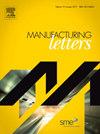利用混合制造和智能装配实现大规模定制:优化配置和平台设计方法
IF 2
Q3 ENGINEERING, MANUFACTURING
引用次数: 0
摘要
混合制造(HM)和智能装配是先进智能制造系统的重要支柱,可为制造商提供高效、适应性强的制造解决方案。本文深入探讨了生产线的配置,该生产线集成了混合制造和装配阶段,每个阶段由多个单元组成,每个单元包含一个或多个并行工位。目标是利用平台概念,将大规模定制推迟到后期阶段,从而最大限度地降低加工成本,制造出一系列最终组件。考虑到可允许的资本成本和机器可用性等约束条件,我们提出了一个数学编程模型,以确定此类生产线的最佳配置。此外,还考虑了对零件系列施加的优先级、包含和隔离限制。所提出的数学编程模型旨在划定哪些 HM 特征在零件平台单元中处理,哪些在大规模定制(零件变体)单元中处理。同时,该模型还能确定在装配平台单元中加工的最终装配组件(HM 阶段的变体),以及在最终装配单元中装配或拆卸的组件。此外,该模型还能确定每个单元所需的工位数量,以满足周期性需求。该模型的总体目标是最大限度地降低资本和加工成本。一个详细的案例研究说明了建议的配置方法和数学模型的有效性。通过使用商业求解器,建议的模型可在几秒钟内求解。本文章由计算机程序翻译,如有差异,请以英文原文为准。
Mass customization using hybrid manufacturing and smart assembly: An optimal configuration and platform design approach
Hybrid Manufacturing (HM) and smart assembly stand as pivotal pillars in advanced smart manufacturing systems, offering manufacturers highly efficient and adaptable solutions for manufacturing. This paper delves into the configuration of a production line that integrates HM and assembly stages, each comprising multiple cells, with each cell housing one or more parallel stations. The objective is to manufacture a family of final assemblies, leveraging the platform concept to defer mass customization to later stages and thereby minimize processing costs. A mathematical programming model is proposed to identify the optimal configuration for such production lines, considering constraints such as an allowable capital cost and machine availabilities. In addition, the precedence, inclusion, and seclusion restrictions imposed on the part family are considered. The proposed mathematical programming model aims to delineate which HM features are processed in the part platform cell versus those processed in the mass customization (part variants) cells. Simultaneously, the model determines the components (variants from the HM stage) of final assemblies processed in the assembly platform cell, as well as components assembled or disassembled in the final assembly cells. Furthermore, the model seeks to determine the required number of stations in each cell to meet periodic demand. The overall objective of the model is to minimize the capital and the processing cost. A detailed case study illustrates the effectiveness of the proposed configuration approach and mathematical model. The proposed model is solvable in a few seconds by using commercial solvers.
求助全文
通过发布文献求助,成功后即可免费获取论文全文。
去求助
来源期刊

Manufacturing Letters
Engineering-Industrial and Manufacturing Engineering
CiteScore
4.20
自引率
5.10%
发文量
192
审稿时长
60 days
 求助内容:
求助内容: 应助结果提醒方式:
应助结果提醒方式:


